I’ve been thinking it’s time I setup a composting system at our new house (we moved three and a half months ago), so I’ve been reflecting on my past composting practices, my knowledge of other composting systems, and how we’ve been living in our new surrounds to figure out what will work best. I’ve also been strolling around the farm looking for salvageable materials to build it. But, it wasn’t until I started thinking about where the best location was that I realised I didn’t need a compost bin, bay or heap at all. It should have been obvious, given my biodegradable waste has not been going to landfill the whole time we’ve been here and in fact, my previous compost system didn’t produce any compost above ground level in the three years I used it!
Why I don’t need a compost unit
- We are good at making as little food waste as possible. Our family of four fills our 4L kitchen caddy on average twice a week. This is markedly different from the average household which fills their landfill bin with 40% food waste each week. That’s 48 Litres for a 120 Litre bin compared to our 8Litres! I don’t leave any food types out of the compost caddy. Dairy, bread, meat, and oils all go in there. It’s important to note that these are miniscule amounts because we don’t waste food and we have reduced our meat intake.
- We have a dog who can eat some of this stuff, but she is rarely treated to it because we rarely have the waste. The only bones we seem to have had for several years is the occasional chicken carcass. It’s dangerous to feed dogs cooked bones so we don’t do this.

- Instead, I use the bones to make stock or bone broth after which the bones disintegrate easily. I add the crumble to the kitchen caddy.

- We also have chickens so I scatter the contents of the kitchen caddy in the chicken yard. The chickens do a good job of cleaning up the scraps, even the chicken bone remains, but things like mandarin peel and corn cobs get left behind. This stuff will continue to biodegrade where it is but it does look messy after it’s accumulated and I don’t want to encourage pests, so I will rake it up and bury it directly in the garden – this is known as dig and drop composting or trench composting.
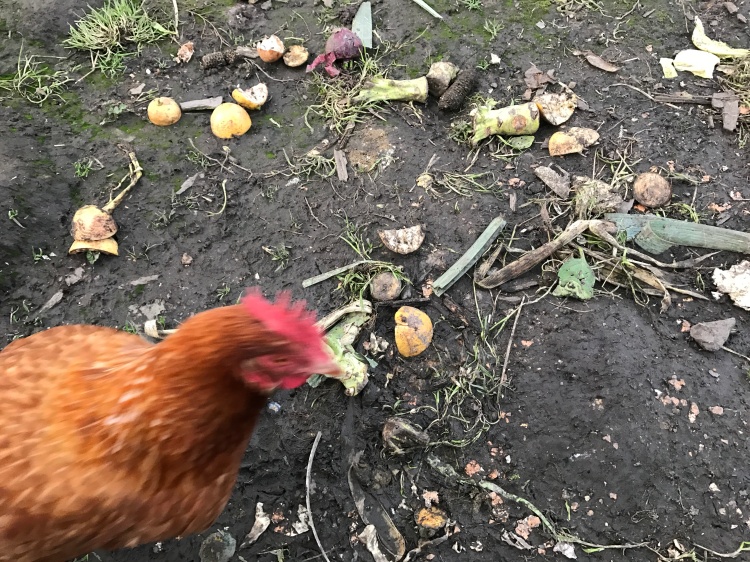
- Occasionally we have other compostable waste that is not reusable or recyclable, like bamboo ear buds, cotton rags, and reused parchment butter wrappers. I have been putting them in our wood heater this Winter. I can’t see anything wrong with this because we are recovering the energy in these items to heat our home and the remaining ash gets spread throughout the gardens when the fire box is cleaned out. Obviously, we can’t do this in the warmer months so that’s when I dig and drop them (here is my post on composting old clothing).
- Then, there is the organic matter from tending to gardens. Prunings, leaves, deadheads and spent plants can be pulled and dropped or cut and dropped in garden beds to biodegrade. Larger pieces can be cut up further with secateurs or mown over.
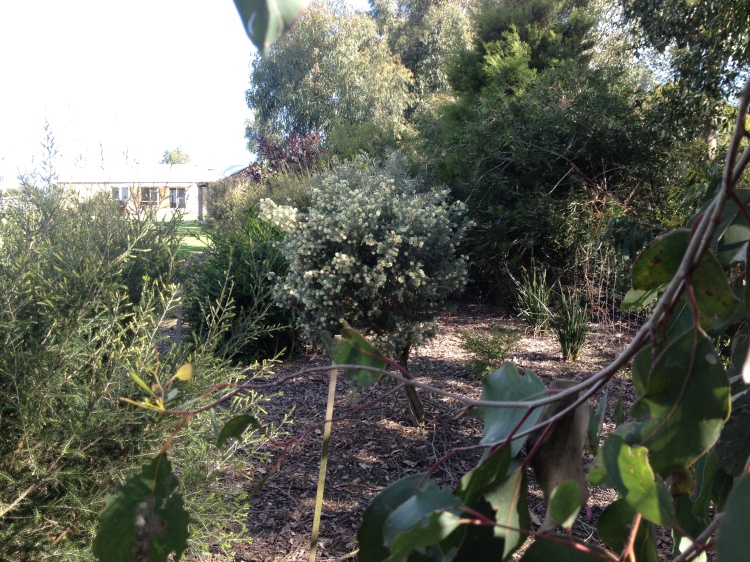
- Difficult weeds are drowned to kill them completely and to create weed tea fertiliser before the remains are discarded discretely on garden beds to break down, but they could be buried too.
- Finally, we don’t have to compost dog poo because our dog runs around free on the farm all day and she does her business in the paddocks. However, you can dig and drop dog poo too. The chickens are also free range but the poo from the chicken house is spread around the fruit trees to fertilise them.
How to dig and drop compost
Above, I’ve highlighted in green the only two circumstances where I actively want to compost using the dig and drop method. There is not a lot of organic matter for each of those circumstances so digging a hole suits me better than digging a trench. You can get really organised with trench composting and rotate the trenches with garden beds if you want but I want absolute simplicity, so here is how I’m doing the dig and drop.
- Dig a hole. This could be in an ornamental or vegetable garden or in a raised garden bed. The hole can be as wide as you like but it needs to be deep enough to protect the compost material from pests, but not so deep that nutrients are leached into ground water. Getting the depth right also keeps the compostable material in the biologically active zone with all the worms and microorganisms. Gardening Australia suggests digging trenches to no more than 35cm deep or 25cm if you have heavy clay soil, so my holes will be dug to 35cm.

- Drop organic matter into the hole, approximately 20cm deep. Don’t compact the scraps as the air spaces are important for providing oxygen and habitat for the soil organisms. A diversity of materials is best to include if you can.
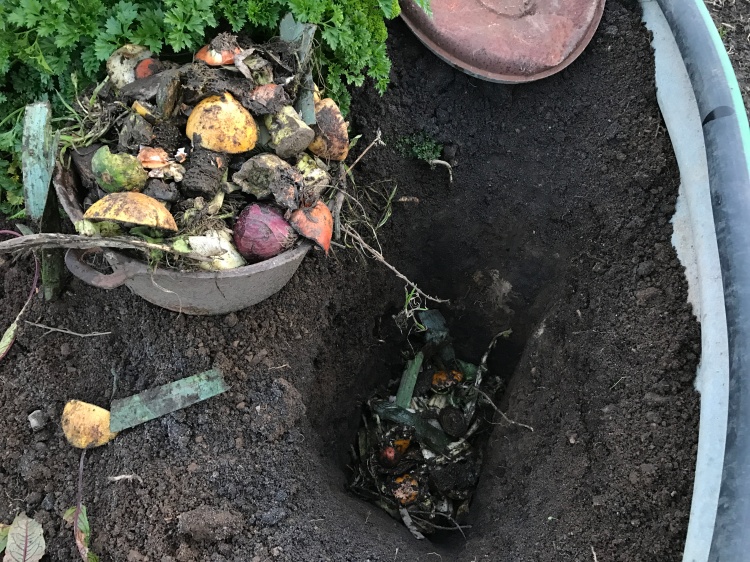
- Replace the excavated soil. This should be about 15cm of soil on top. Decomposition is pretty fast so you can even plant seeds and small seedlings on top.
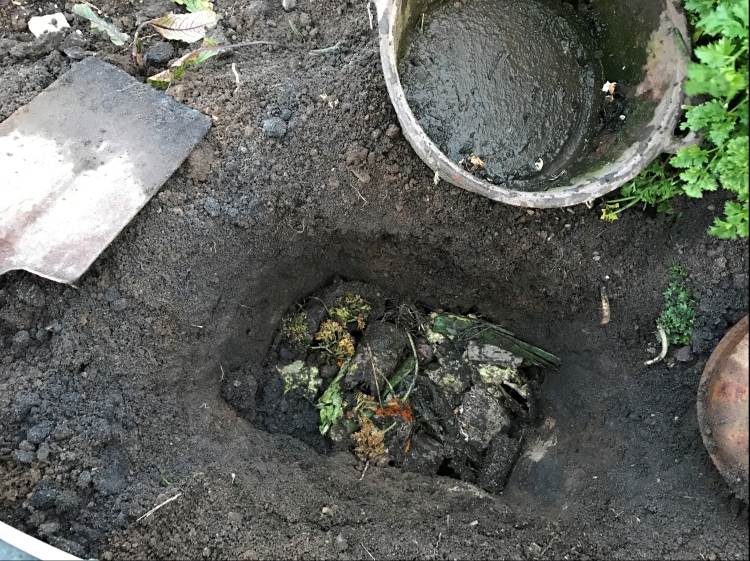
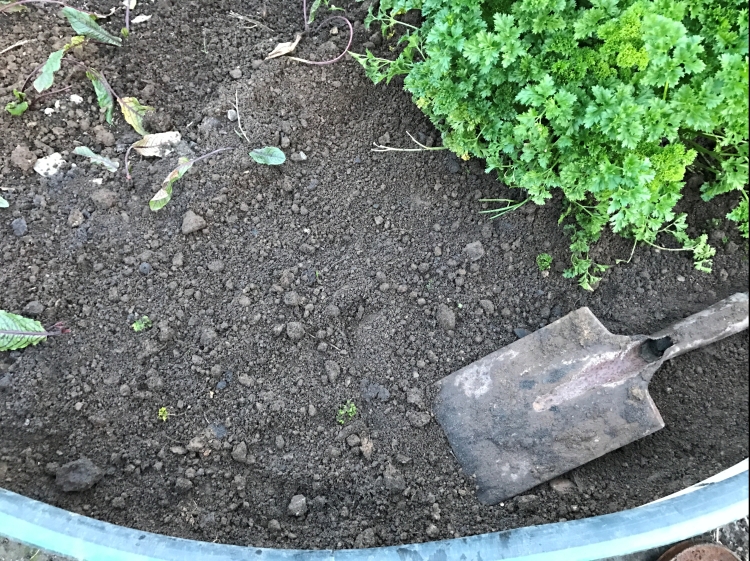
That’s it! I won’t need to dig new holes very often because of the small amount of material needing composting. I even use a lid to cover the hole to keep pests out until it is full enough to top with soil.
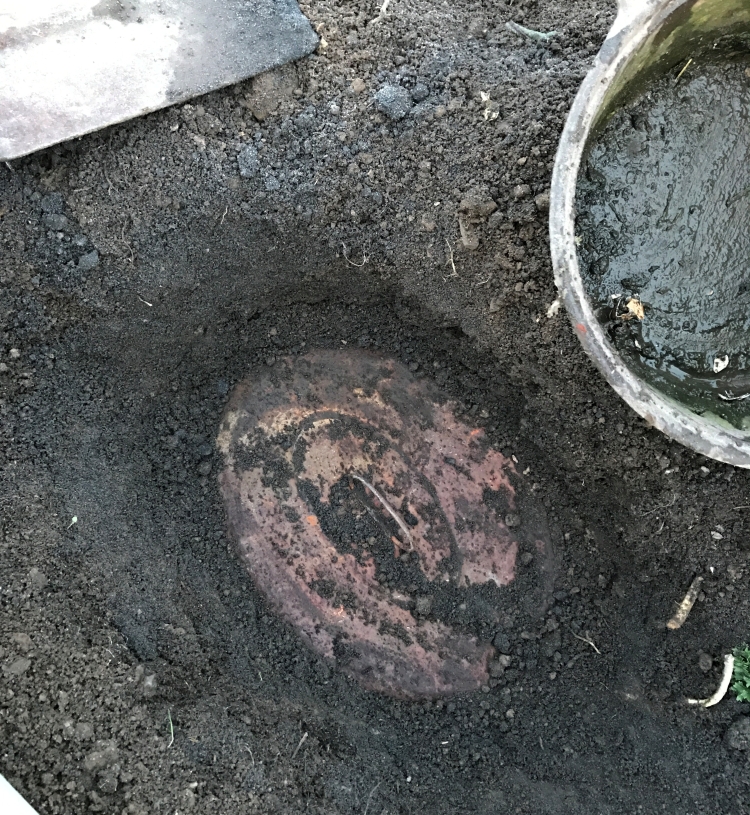
Doing this reminded me of a Gardening Australia episode I saw last year, so I searched for it and found it under Costa’s free range worms fact sheet. It’s essentially Dig and Drop composting except he uses a bucket with holes to contain the scraps and allow the worms to come and go as they please. It’s a cool idea but if you ask me, Dig and Drop composting is the ultimate for free-range worms.
The benefits of dig and drop composting
Dig and drop composting has a lot of benefits over other composting methods, including:
- It saves space in the garden. Digging holes is a great solution for people with small yards.
- There is no smell (not that I have ever had that problem).
- It’s very frugal. All you need is a shovel. There’s no expensive units to set up or ongoing inputs to purchase like bokashi bran.
- It’s zero waste. There are no end of life issues to manage as with plastic bins and worm farms.
- It’s less work. There’s no ratios of browns and greens to worry about, less raking and carting of garden materials, no turning necessary, no need to think about moisture levels or pests, no need to harvest and distribute the compost because it is already in the ground doing it’s job!
- Decomposition is fast because the contents is well insulated and kept moist, and all the microorganisms and worms have direct access. Most things will breakdown in one month to six months. If you want to speed up the process, cut up the organic matter or process it in a blender first.
- It deters pests.
- It’s great for neighbouring plants and it improves soil, especially in compacted areas.
Do you, or would you use dig and drop composting and free-range worms?


Us RUDE [reusers of unloved discarded excess] Guys have used this method for years. It’s very quick and effective. We dig the compost [one large bowl per day] into our small potager garden and it has improved the soil. Thank you for sharing your experiences with this method.
LikeLiked by 2 people
No worries RUDE Guys! Thanks for sharing all your experience too.
LikeLiked by 1 person
Love this! We’re looking at buying a house (currently renting) and was wondering what to do when we move, as I didn’t want to buy/make a new compost bin. This is ace! I can’t believe I hadn’t thought of it sooner either! My dad is an avid gardener but he has an established compost bin and then just scatters the compost through gardens as he needs it, but I think this would save heaps on double handling.
LikeLiked by 1 person
The good thing about this method is that you won’t lose anything by just giving it a go. If it doesn’t turn out then you can easily try something else.
I think composting often fails for people because they didn’t look into the different methods enough to find something that matches their lifestyle and their home habits.
LikeLike
I follow this practice and learned it from my Dad many (nearly 50!) years ago. He had the best veg garden. I would caution against feeding chicken meat or chicken bone scraps to chickens, though – quite apart from the ethics of it, it poses a real risk of disease transmission to your flock and is a very important biosecurity issue to be aware of with all other livestock (that’s why chook pellet bags have warnings not to feed the pellets to ruminants, as the pellets contain meat meal from sheep or cattle). I believe it’s just good practice not to feed an animal remains of the same sort of animal. The UK learnt this the hard way with Mad Cow disease. Funny how ethics often has it’s roots in common sense. While I don’t know of prion diseases that affect chooks, yet, why encourage the environment in which it can come about?
Double digging, though, what treats for the worms and the veggies!
LikeLiked by 1 person
Hi Cathy, I’ve seen this issue debated in other places too and you are right, disease transmission is worthy of consideration and acting responsibly. My chickens are only getting the disintegrated bones, once in a blue moon, after they have been cooked for 24 hours so I think the risks here are very small. Nevertheless, I could easily leave them out and put straight into the dig and drop hole. 🙂
LikeLike
Agree completely, Cathy,
LikeLike
P.S. Hope I didn’t sound critical about the chicken scrap thing – I only became aware of it through working in an operating theatre ( and being made aware of the human type of Mad Cow disease) and then through keeping livestock – it took me a bit of doing to join the dots on this and, really, it shouldn’t have! You’re far from the first person I’ve come across to feed chicken scraps to their chooks… it’s worth considering the disease risk, that’s all. And your blog is fabulous and I love what you’re doing, you’ve given me so many ideas and empowered me to deal with my own stuff properly (and to minimise it to begin with). You’re doing a fab job and I’m really a mad keen fan!!!
LikeLiked by 2 people
Thanks Cathy, I really appreciate the feedback and I’m so glad to be helping others! You didn’t sound critical at all.
LikeLike
I know this is over 3 years late but I want to say how pleased I have been to discover your recommendation of D&D composting. In a tiny garden like mine (on a new-build development in UK) there just isn’t space for a heap or anything else – and the whole space is visible from the house too. I had an instinctive idea that I ought to be able to bury the stuff but it’s so good to read other people’s proofs that it works. I am still trying to find out if D&D might produce methane though (apparently that happens if the process becomes anaerobic).
LikeLiked by 1 person
Love the idea of dig and drop composting. My parents did this for years in their suburban garden. We have a Bokashi Bin on our kitchen bench and place food and organic scraps along with a teaspoon or two of Bokashi mix ( a blend of bran and soil friendly microbes ) in layers. The mix begins a fermentation process, with the liquid produced making an excellent fertilizer and drain cleaner which is drained off from a tap at the bottom of the bin. Because the contents are slowly breaking down in the bin it takes up to 6 weeks to fill the bin to the top. Then the contents are buried in the garden, complete with some soil friendly microbes to help build soil health. The contents break down very quickly and then the whole process begins again as the bin is slowly refilled once more.
LikeLiked by 1 person
Sounds like you’ve found a system that you really like. I’ve heard heaps of people rave about bokashi bins but I often wonder with the bokashi set up if it becomes a bother to buy the bran. I’ve only avoided the bokashi system because I like to avoid all forms of packaging and reduce the things I consume to a minimum.
LikeLike
I also have a Bokashi Bin and when i ran out of bran i didn’t buy anymore. I now use the bin as a collection bin and do the dig and drop method. It can be a burden dropping 20L of kitchen scraps into a hole, and we have very hard clay which is a nightmare to dig into, but one day my garden will be beautiful and it will be well worth it.
LikeLiked by 1 person
We’re about to move to a place with lots of garden space and this sounds really appealing vs. building a freestanding structure!
LikeLiked by 1 person
Give it a go, you’ve got nothing to lose! 😃
LikeLike
This is really quite brilliant! I’d love to feature your post on my blog if you’d allow me! If not that’s okay too Xx
https://home-love.ca/2018/02/03/know-a-good-homesteading-hack/
LikeLiked by 1 person
Thanks Destiny. 😊 I’m happy for you to introduce my post on your blog and link to it, if that suits what you had planned. Thanks for asking xx
LikeLike
Yes thank you! I’ll be publishing closer to the end of Feb and will link back of course. Thanks again Xx
LikeLike
Recently discovered this method, it makes perfect sense and suits my way of life. I don’t have my chickens yet and I was given a worm farm as a gift so I do a 1:4 dump between my worms and the drop compost.
Don’t know why something so simple and sensible gets all complicated by commercialism 🙄
LikeLiked by 1 person
I absolutely agree! 🤷🏻♀️
LikeLike
Love this Tammy! I have tried other above ground compost systems and have found it difficult to get the mix right, either too wet or too dry. It also made me remember that my dad, who had a brilliant vege garden, Used to do a similar version of the trench compost system. He would dig in some vege plants that had reached the end of their productive life, (if they weren’t too woody?) and that would provide nutrients to the soil for the next crop. 💚 thank you – I’m definitely going to try this.
LikeLiked by 1 person
Thanks Sarina, I hope it works out for you too. 🙂
LikeLike
This is really useful. I’ve been looking for the easiest way for me to compost and this might be it, as I’ve got a garden. You largely mention food scraps though. Could I just drop anything natural, including hair and tissues?
LikeLiked by 1 person
Yes absolutely. Anything natural. 🙂
LikeLike